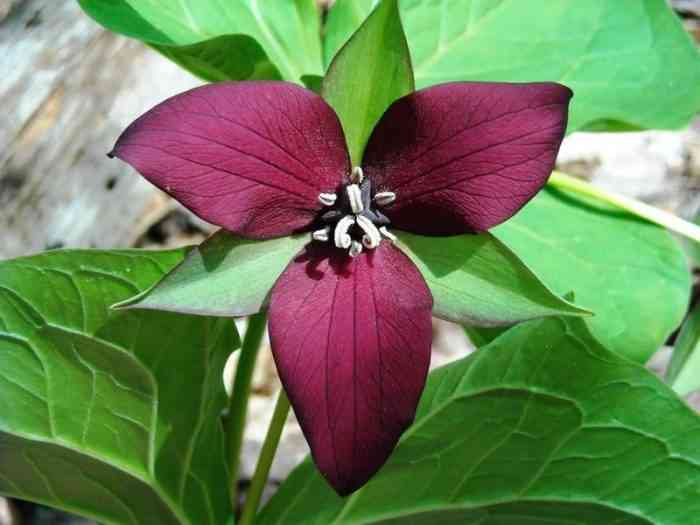Red Trillium, a Popular Wildflower
Red trillium, one of the most popular forest wildflowers, ushers in spring with its lovely, fragrant, maroon-purple blooms. It is one of the most iconic native perennial flowers. It has three leaves, three petals, and three sepals.
This beautiful plant looks best when planted in groups or blended with other forest wildflowers and ferns. It has a clumping habit and grows 6–12 inches tall with a 12-inch spread.
Quick Growing Guide
Botanical Name: Trillium erectum
Also Called: Wake Robin
En français: Trille dressé
Blooms:
Sun / Shade:
Water: Let top inch of soil dry before watering
Soil:
Height:
Pollinators:
Read about the White Trillium, a sister plant, in the same botanical family.
Appearance
Red trilliums are perennial wildflowers with a single central stem and three widely spreading leaves that can reach heights of 6 to 20 inches. Light to purple-green and silky, the stems are sturdy (hairless).
Three whorled leaves are present on each node of the Red Trillium. From the flower stalk’s base, unstalked leaves emerge. The purple or maroon petals, three light green to greenish maroon sepals, and six stamens of the Red Trillium’s flowers measure two to three inches in width. A short, erect, or curved stalk carries the blooms, which are held 1-4 inches above the plant’s leaves.
Growing Red Trillium
Planting red trilliums in between bushes that offer wind protection and shade is ideal. A shaded border next to a wall or fence is another option.
Plant on rich, loamy, or humusy soils with good drainage and a pH that is neutral for optimum growth. Some species favor soils rich in limestone, whereas others favor acidic soils. When blossoming, they can tolerate a lot of water but prefer a dry, dormant time (late summer through winter).
Despite their love of wetness, red trilliums cannot survive waterlogging. Heavy, damp clay soils are not conducive to their growth. Raised bed gardening is one solution. Another option is to remove the clay to a depth of two spades and replace the space with a mixture of loam, garden compost, thoroughly decayed animal manure, and decomposed bark bulked up with sharp sand.
Red Trillium are forest wildflowers, and while they may tolerate some sun, they prefer heavy shade. Protect against the strong midday sun and stay away from western exposures. Even though the excessive darkness of evergreens can prevent trilliums from growing, a deeper shadow is acceptable in the summer.
Red Trillium Care
Add leaf mold or organic fertilizer when it’s ready to plant. Trilliums don’t need fertilizer on a regular basis, but a late winter spray may be beneficial. Lovers of alkaline soil value an annual lime dusting.
Most trilliums appreciate shallow planting in the garden, 3 to 4 inches below, despite the depth of wild rhizomes. Clear away dense leaf litter to allow seedlings to germinate. Search for “nursery-propagated” purple trilliums when buying them.

Habitat
Trilliums are endemic to zones 3 and 9, respectively. The purple trillium is indigenous to Ontario, Quebec, and Michigan. It can also be found in Indiana and Illinois, to a lesser extent.
They can frequently be grown outside of their native areas between the north and south, although the East and West coasts are more difficult to adapt to. A mild marine climate is preferred for West Coast species.
Uses
Many Native Americans in North America employed the red trillium’s root as a birthing aid, giving it the popular names birthwort and birthroot (which is sometimes corrupted to bethroot). Root tea has been used to treat menstruation irregularities, induce labor, and facilitate delivery. The Cherokee used the entire plant as a salve to heal tumors and inflammation.
Tumors, inflammatory conditions, and ulcers were all treated using a poultice made from the entire plant. Additionally utilized as a treatment for ulcers and coughs was purple trillium.
There aren’t many edible uses for the plant. Some advise adding the leaves (gathered before the blooms appear) to salads or cooking them to use as a vegetable. Both the berries and the roots are poisonous and inedible.
Fruit and Relationships with Nature
In the event that pollination of the Trillium flower is successful, a fruit forms. Then, it ripens later in the summer. The fruit is a berry that splits apart when it is ripe, releasing its numerous seeds for spreading. Each seed is connected to an elaiosome, a nutrient-rich food package whose chemical composition resembles that of an insect. This mechanism has developed to draw ants and help the seeds spread. It works because ants are omnivores; they consume some plant matter and like sweet pleasures like nectar, but a substantial component of their diet includes insect protein.
The elaiosome on the seeds is what draws ants to them. They carry the seeds back to their houses, consume the elaiosome, and then throw the seed on their compost pile, thereby sowing it in a hospitable, secure environment. Many spring-blooming wildflowers use this evolutionary technique.
Companion Plants for Trillium Erectum
Hepatica, epimedium, cyclamen, dicentra, erythronium, primula, sanguinaria, and Arisaema are all suitable purple trillium planting companions. They grow well alongside spring-flowering bulbs like scilla, chionodoxa, and anemones as well.







Leave a Reply
You must be logged in to post a comment.